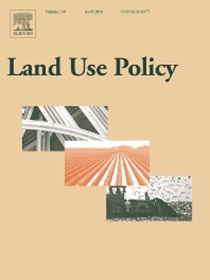黄金还是农作物:埃塞俄比亚北部金矿景观中农业土地恢复实践的偏好
IF 5.9
1区 社会学
Q1 ENVIRONMENTAL STUDIES
引用次数: 0
摘要
发展中国家的传统金矿开采造成了严重的土地退化,威胁到自给农民的生计和粮食安全。黄金开采和土地退化的核心问题在于农民对黄金和农作物的不同偏好。了解这些偏好将有助于促进恢复实践,不仅可以改善土壤健康,提高金矿农业景观的生产力,还可以使农民继续从黄金中获得额外收入。本研究的目的是评估农民对受三峡工程严重影响的农用地采取恢复措施的偏好和接受补偿的意愿。通过选择实验,评估农民对土壤修复措施的偏好和接受补偿的意愿,包括接种丛枝菌根真菌(AMF)、植物修复和水土保持结构。这个实验评估了农民愿意在这些做法和补偿之间做出的权衡。调查结果显示,农民不愿放弃目前的金矿开采做法,因为他们从黄金开采中获得收入。这突出表明需要建立补偿机制来激励采取恢复措施,这不仅反映了农民将放弃的收入,也反映了与恢复工作相关的高初始投资和管理成本。农民对水土保持措施和种植耐重金属树木表现出积极的偏好。然而,他们表达了对AMF接种的负面偏好,表明对其有效性或成本的担忧。有趣的是,农民更倾向于支持成本更高的修复措施,如水土保持结构,前提是有强有力的交叉合规机制来保护他们的长期投资。这表明,恢复实践的成功采用可能不仅取决于财政激励,还取决于确保这些投资可持续性的强有力的政策和支持结构。该研究强调,迫切需要精心设计的财政激励和政策支持,以克服农民不愿从金矿开采转向土地恢复的问题。本文章由计算机程序翻译,如有差异,请以英文原文为准。
Gold or crops: Preferences for agricultural land restoration practices in gold-mined landscapes in northern Ethiopia
Traditional Gold Mining (TGM) in developing countries causes significant land degradation, threatening the livelihoods and food security of subsistence farmers. At the center of this gold extraction and land degradation lies farmers’ divergent preferences for gold and crops. Understanding these preferences will help promote restoration practices that not only improve soil health and enhance the productivity of gold-mined agricultural landscapes but also allow farmers to continue generating additional income from gold. The objective of this study is to evaluate farmers’ preferences and their willingness to accept compensation for adopting restoration practices on agricultural lands severely impacted by TGM. A choice experiment was conducted to assess farmers’ preferences and willingness to accept compensation for implementing soil-based restoration practices, including arbuscular mycorrhizal fungi (AMF) inoculation, phytoremediation, and soil and water conservation structures. This experiment evaluated the trade-offs farmers are willing to make between these practices and compensation offers. The results reveal farmers’ reluctance to abandon current gold-mining practices due to the income they derive from gold extraction. This highlights the need for compensation mechanisms to incentivize the adoption of restoration practices, which reflect not only the income farmers would forgo but also the perceived high initial investment and management costs associated with restoration efforts. Farmers showed a positive preference for soil and water conservation measures and planting heavy metal-tolerant trees. However, they expressed negative preferences for AMF inoculation, suggesting concerns over its effectiveness or costs. Interestingly, farmers were more inclined to support higher-cost restoration practices, such as soil and water conservation structures, provided there are strong cross-compliance mechanisms to safeguard their long-term investments. This indicates that successful adoption of restoration practices may depend on not just financial incentives but also robust policies and support structures that ensure the sustainability of these investments. The study highlights the critical need for well-designed financial incentives and policy support to overcome farmers’ reluctance to shift from gold mining to land restoration.
求助全文
通过发布文献求助,成功后即可免费获取论文全文。
去求助
来源期刊

Land Use Policy
ENVIRONMENTAL STUDIES-
CiteScore
13.70
自引率
8.50%
发文量
553
期刊介绍:
Land Use Policy is an international and interdisciplinary journal concerned with the social, economic, political, legal, physical and planning aspects of urban and rural land use.
Land Use Policy examines issues in geography, agriculture, forestry, irrigation, environmental conservation, housing, urban development and transport in both developed and developing countries through major refereed articles and shorter viewpoint pieces.
 求助内容:
求助内容: 应助结果提醒方式:
应助结果提醒方式:


